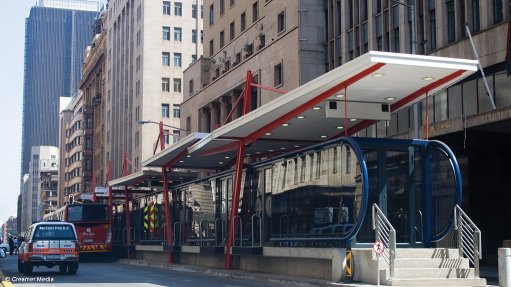
THE BUS STOPS HERE Transport systems depend on the quality and sustainability of the associated infrastructure, therefore government has to invest in infrastructure to increase mobility and grow the economy
Photo by: Duane Daws
The Council for Scientific and Industrial Research (CSIR) has been researching the use of alternative materials, including waste by-products, in road construction to reduce costs, enhance engineering properties and ensure the sustainability of the environment.
CSIR Built Environment Transport Infrastructure Engineering (TIE) competence area principal researcher Dr Martin Mgangira notes that his research into material design optimisation is aimed at maximising alternative materials to ensure the aforementioned outcomes.
He adds that the project is driven by the need to conserve natural resources and efforts to reduce environmental impact by increasing the replacement ratio of raw materials with nonconventional materials, including industrial by-products.
Further, his work over the past three years has expanded upon research from the mid-90s, which explored the viability of using waste by-products, such as phosphogypsum, coarse and fly ash, blast furnace and steel slag, as well as crumbed rubber and fibres from waste plastic bottles.
The CSIR’s ongoing work with these by-products has been assisted by collaborations with South African petrochemicals giant Sasol and State-owned power utility Eskom, which have supplied some of the materials.
Mgangira states that these materials can add value in terms of achieving a specific performance requirement, such as a smoother, stronger, shock-resistant or longer-lasting road surfacing and good road substructure.
Although these materials are easily sourced and, while they need to be processed and treated to achieve specific performance outcomes, the cumulative nature of the benefits, including the potential cost, and environmental and performance-based benefits, far outweigh any detriments that are entailed by the need to process materials. There is also a feasible transport distance to consider.
Another CSIR research project, spearheaded by TIE principal researcher Dr Joseph Anochie-Boateng, investigates the use of crushed glass as an aggregate replacement in asphalt. Anochie-Boateng’s glass-asphalt mix also seeks to derive economic, environmental and performance benefits.
He notes that the Department of Science and Technology (DST) has launched a Waste Research, Development and Innovation Roadmap, which aims to reduce the amount of waste products taken to landfills by 20% by 2022. The DST believes that this goal can be achieved by developing innovations that reuse or recycle waste materials, contributing to the green economy and hopefully stimulating job creation.
Anochie-Boateng explains that the benefits of using glass are its reflectiveness, which can assist with improving visibility, especially under lights; and its being water- resistant, as it cannot absorb water, subsequently resulting in roads drying faster after rainfall, improving safety.
Additionally, crushed glass can be used to reduce the amount of bitumen – the most expensive component – in asphalt formulation, reducing the cost of road construction.
Further, glass is recyclable, biodegradable and easily sourced, as significant amounts are readily available at South African landfills, and crushed glass’ low density means that it provides more volume per tonne.
Over 900 000 t of glass waste are estimated to have been generated in South Africa in 2011. Of that, only 300 000 t was recycled. This means that the rest, about 600 000 t, ended up in landfill. According to a major glass manufacturing plant in Gauteng, about 13 000 t a month of crushed glass is recycled of which 3 000 t, representing glass smaller than 5 mm, is considered as waste. This can be used as sand replacement in asphalt mix, Anochie-Boateng explains.
He notes that the percentage of crushed glass added to the asphalt mix will affect the stability of the road surface. Initial test results indicate that an asphalt mix that comprises 15% crushed glass seems to offer the most stability, Anochie-Boateng adds. However, this combination can be tinkered with, depending on the traffic volume of road, as he notes that a trial project in Australia used a 5% crushed glass mix on low-volume roads successfully.
Both Mgangira and Anochie-Boateng’s projects are in the laboratory testing phase, with trial phases expected to occur within the next two to three years, depending on results and industry or private–public participation and sponsorship.
Mgangira concludes that the feasibility of any road transport systems directly depends on the quality and sustainability of the road infrastructure. Further, good road infrastructure goes a long way towards ensuring driver, passenger and pedestrian safety, reducing vehicle maintenance and enhancing the overall travel experience.
The doctors presented their research initiatives at the thirty-second Road Pavement Forum, which took place on November 7 and 8 at the CSIR International Convention Centre.